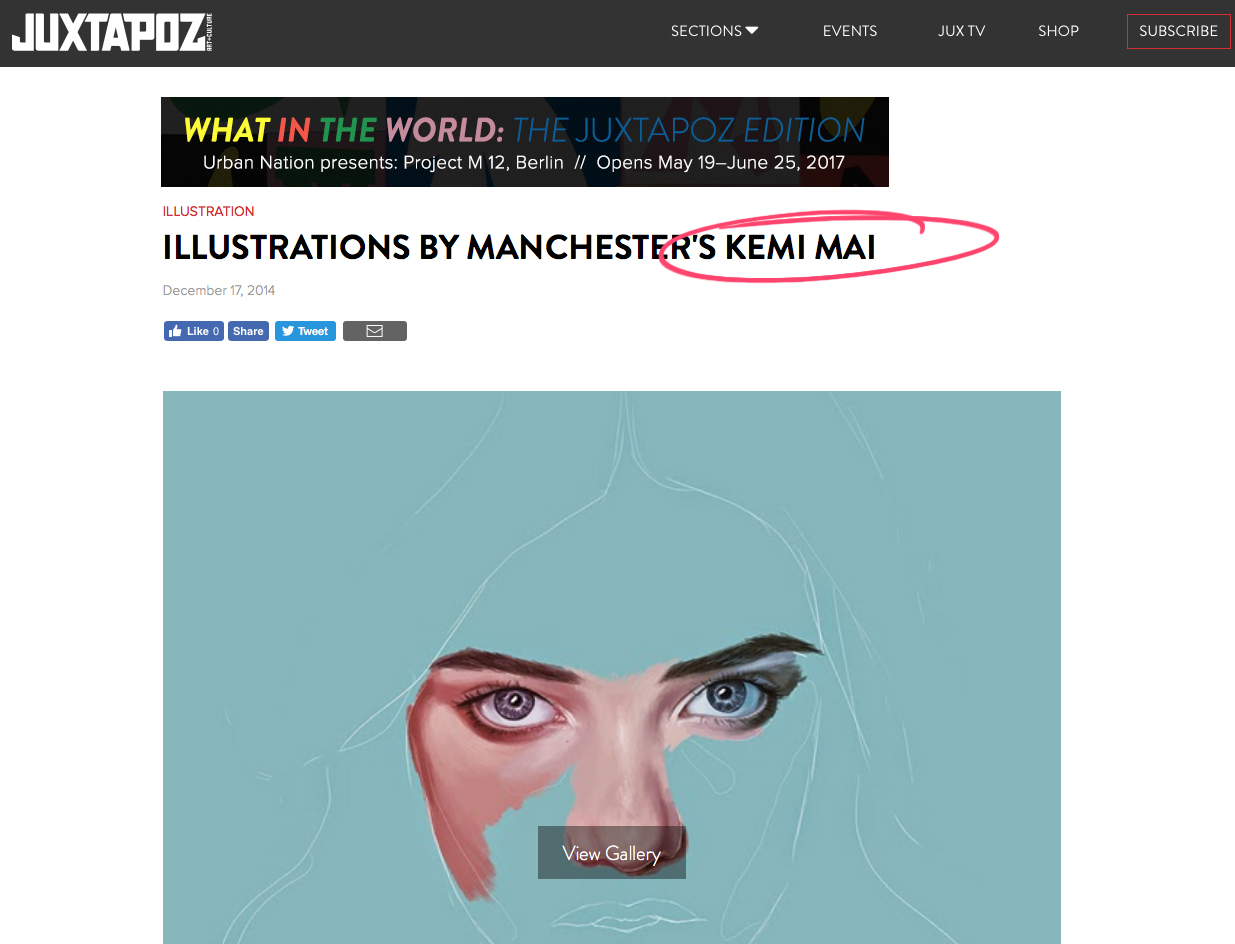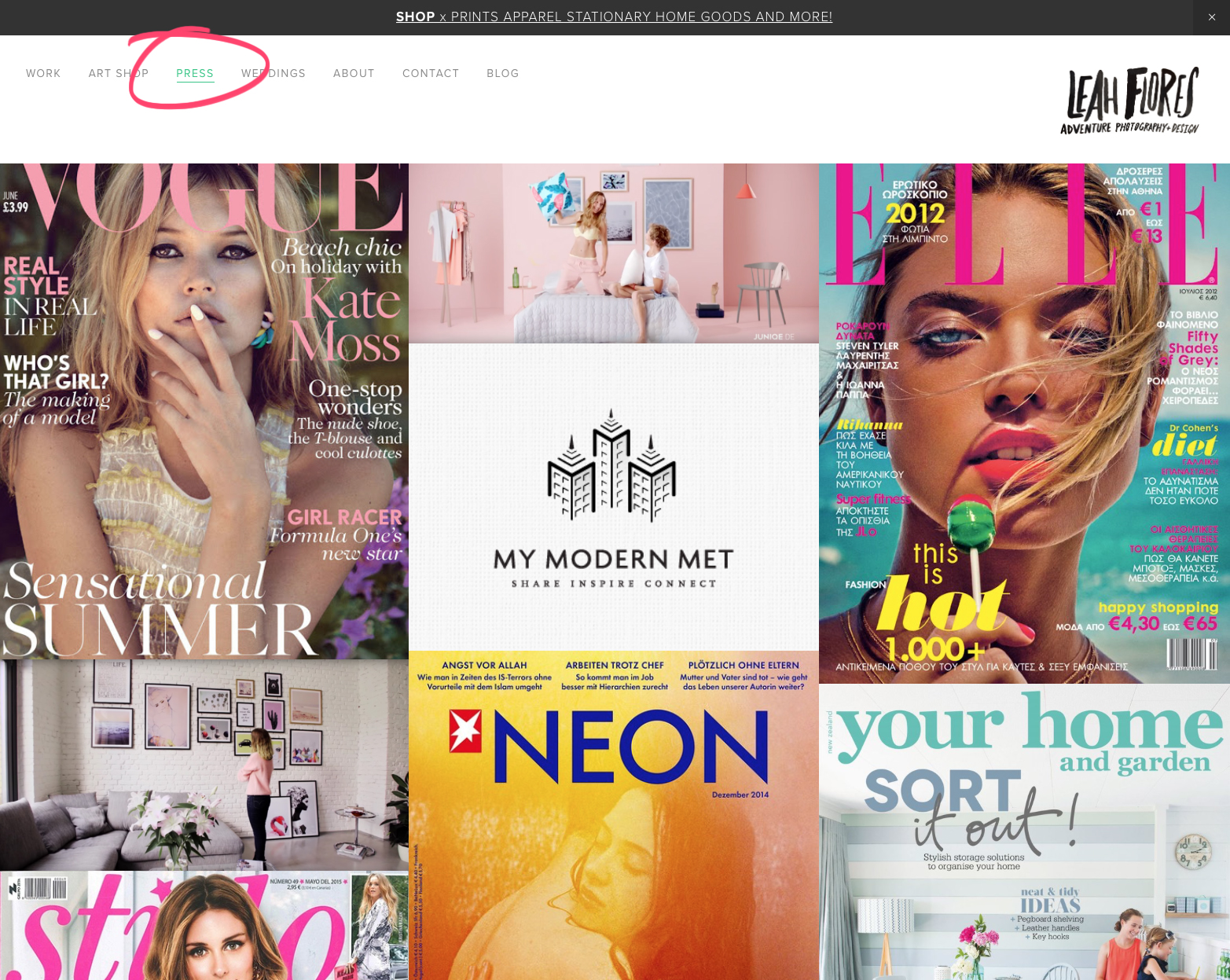You know where to pitch. Now, seal the deal.
We put writer Angella D’Avignon to task by compiling the best advice from several well-respected artists in the community.
A solid pitch is just the start to getting your work out into the world. Once you have a stunning line-up of work and you know who you want to work with and where you want to be featured–what’s next? Pitch basics are pretty simple: include a brief introduction or bio about who you are and what you’re pitching, a few images of your best work (depending on someone’s email inbox, images may show weird, so attachments of individual pieces are always a safe bet), and links to your portfolio should they be interested. Make sure to directly address the editor by name if you know it. If not, a polite salutation will do.
I can’t stress how much a couple of good features can do for an emerging artist. -Kemi Mai
1 | Pitch frequently
Pitching can be a bit of a guessing game and you may encounter more rejection than acceptance when you first start. But don’t get discouraged–pitching again and again is de rigeur. Don’t think of it as striking out, consider this a warm up. Once you learn what editors are responding to, stick to it and you’ll hit more home runs.
Kemi Mai: “When you’re new to the game, submit, submit and then submit again. I can’t stress how much a couple of good features can do for an emerging artist. Sometimes all it takes is a platform and it’s up to you to find it. I submitted my work to a lot of my favourite art communities and magazines, such as Juxtapoz and Supersonic Art. Initially, however, nothing I sent in was ever posted, then a few months down the line I’d been featured several times. Put yourself out there, because as cliche as it sounds, you never know what might happen.”

2 | Know your audience and follow submission rules
Gear your pitch to specific publications or magazines. Check out submission guidelines if provided – this can make or break your pitch! Double check your formatting, too.
Lisa Argyropoulos: “It really depends on the target audience. Sometimes, they want you to provide an image sheet for them, or maybe just links so they can view themselves. What is your artwork going to be used for? Are you doing it for a fee? What’s involved? Are you drumming up the business, or did they approach you? What is their business all about?”
The more catered your pitch is to the publication, the more success you’ll have.
3 | Leverage social media and keep your brand clean and consistent
An easy way to be memorable is to maintain a motif–not a shtick, but a recognizable symbol or style that people associate with you. And only you.
Sara Eshak: “I usually do outreach through Twitter, Facebook, and Instagram. My online portfolio is easily accessible via mobile. It’s displayed on Instagram and Tumblr. This is a great time for artists to connect on an interpersonal level with other artists, vendors, buyers, events, collaborators, PR, and brands. Communicate a single, simple message. People have trouble remembering someone’s name, let alone anything complicated. Use the ‘KISS’ principle used by advertisers: Keep It Simple, Stupid.”
In other words, be clear and direct. Most people reviewing your work don’t need a long spiel. Your work should do a majority of the talking. If they have 100 pitches to read through, burying the best stuff in a long-winded pitch can be a turn off. So, keep it simple and in your voice.
Spoken like a pro, Kit King also keeps it simple: “I would send an email that is short and to the point with the top three best examples of my work. Be kind and polite. Be confident without being conceited.”
Further, make use of social platform messaging to get quick access to their social teams–which can share with their companies. Access to a publication (or any brand really) is easier than ever.

4 | Show a publication you understand their brand
You can instill confidence in a potential publisher by showing that you’ve been vetted by other publications. The larger the publication, the better.
Leah Flores: “I feel that when reaching out to a potential new client or feature opportunity, it’s important to not only showcase your artwork in the best way possible (having a current website, keeping active social media accounts, and having a strong, overall portfolio), but to tell them why you are a good fit for their company, blog, gallery, or site. Show that you are familiar with their style, their audience, and have done your research! When I am written by prospective clients I am much more likely to respond if I can tell that they sent me a custom email, know me and my work, and really want to work with me rather than receiving a copy and paste form letter.”

5 | Pitch newer work with an accompanying compelling narrative
Natalie Foss: “I think that when you have a story to tell, or adding a lot of your personality to the project you’re pitching, you’ll get the best results. Write the idea in a professional way, and show examples of your work. Tell what you’re able to do, and how the result will look. Show how your sketch look vs how the final product will look, so they know what they will get. I’ve experienced a few clients who don’t understand that my sketches are actually sketches and not the final work.”
6 | Pitch unpublished work
Publications love an “exclusive release” of new work. Before you begin self-publishing on your website or any social channel, collect your best work from a recent collection and share with the most compatible publications. Someone is bound to pick it up if you’re reaching out to the right sites.
PRO TIP: Make sure to provide publications with a link to your shop or anywhere else you’d like readers to visit based on the feature you’re pitching.
7 | Celebrate your successes!
If there’s any time to show off, it’s now. Publications are going to elevate your successes as it brings them more clout with their readers. Don’t forget to share the big names you’ve worked with. Sometimes it’s just the hook a publication needs to say “yes” to featuring you.
PRO TIP: Add a short list of your biggest name clients to your pitch (or maybe even your email signature).
Robin Eisenberg recommends sharing success via social media on the regular: “I’ve found that a simple post sharing your success or event works best. Expressing your genuine excitement is also infectious and gets other people excited. Sharing images or visuals of the project or artwork from the article is also really good (at least in my experience).”
Overall, pitching your work isn’t that tough. It’s just a matter of doing it. Gather your best work, put together a short and concise description of your work, then quickly illustrate how a publication’s readers would love what you’re offering. After a handful of swings, you’ll figure out what’s working and what isn’t. Adjust your pitch and start swinging for the fences.
Featured artwork by Jodi Hildebrand

Comments